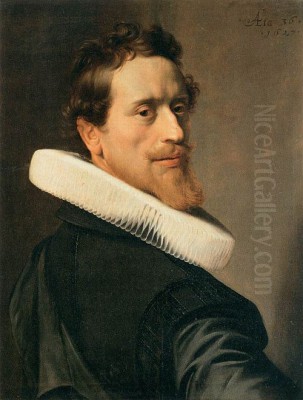
Nicolaes Eliasz. Pickenoy stands as a significant, if sometimes overshadowed, figure in the rich tapestry of Dutch Golden Age painting. Active primarily in Amsterdam, he was a prolific and highly skilled portraitist, capturing the likenesses of the city's burgeoning elite during a period of unprecedented prosperity and cultural dynamism. His meticulous technique, keen eye for detail, and ability to convey the status and character of his sitters made him a sought-after artist, bridging the gap between earlier, more rigid forms of portraiture and the more psychologically nuanced works of his contemporaries like Rembrandt.
Early Life and Artistic Formation
Nicolaes Eliasz. Pickenoy was born in Amsterdam on January 10, 1588. His father, Elias Claeszoon Pickenoy, was a stonemason originally from Antwerp, suggesting a family background connected to the arts and crafts, albeit not directly to painting. His mother was Heijltje Laerszoon Jongs de'. The family's presence in Amsterdam indicates their participation in the city's growth, which attracted artisans and merchants from across Europe, particularly from the Southern Netherlands.
The precise details of Pickenoy's artistic training are not definitively documented, a common challenge when studying artists of this period. However, art historians have proposed several influential figures as his potential mentors. One prominent name is Cornelis van der Voort (c. 1576–1624), a leading portrait painter in Amsterdam in the early 17th century. Van der Voort's style, characterized by its clarity, detailed rendering of costume, and somewhat formal compositions, can be seen as a precursor to Pickenoy's own approach. If Pickenoy did study with Van der Voort, he would have been immersed in a successful portraiture workshop that catered to Amsterdam's elite.
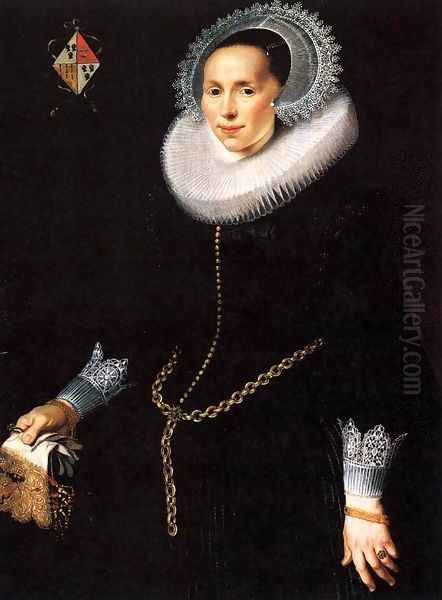
Another possibility, though perhaps less direct or as a secondary influence, is Bartholomeus van der Helst (1613–1670). However, given that Van der Helst was significantly younger than Pickenoy, it is more likely that Van der Helst was influenced by Pickenoy, or that they were contemporaries who influenced each other, rather than Van der Helst being Pickenoy's primary teacher. Some sources even suggest Van der Voort was a teacher to Van der Helst. The artistic environment of Amsterdam was a crucible of shared techniques and evolving styles, making direct lines of tutelage sometimes complex to unravel. What is clear is that Pickenoy emerged with a technical proficiency that placed him among the city's foremost painters.
Establishment in Amsterdam and Personal Life
Pickenoy's career was firmly rooted in Amsterdam, the bustling commercial and cultural heart of the Dutch Republic. In 1621, he married Levijtje Bouwens, who was an orphan. This marriage marked a significant step in his personal and professional life, likely solidifying his social standing within the city. The couple went on to have ten children, though sadly, two of them, Sara and Elias, died in infancy, a common tragedy in an era of high child mortality.
His success as a painter enabled him to purchase a house in Amsterdam, a testament to his financial stability and established reputation. He became an integral part of the city's vibrant art scene, a community that included painters, patrons, dealers, and connoisseurs. His most productive and arguably most influential period is considered to be between 1630 and 1637. During these years, he received numerous commissions for both individual and group portraits, as well as some historical and biblical paintings, showcasing his versatility.
The demand for portraits in 17th-century Amsterdam was immense. Wealthy merchants, civic officials, members of guilds, and directors of charitable institutions all sought to have their likenesses preserved, both as personal mementos and as public declarations of their status and achievements. Pickenoy was adept at fulfilling these commissions, creating images that were both accurate representations and flattering portrayals.
Artistic Style and Characteristics
Pickenoy's artistic style is distinguished by its meticulous attention to detail, particularly in the rendering of fabrics, lace, and accessories. He possessed a remarkable ability to depict the varied textures of silk, velvet, starched linen, and intricate gold embroidery, which were hallmarks of the affluent attire of his sitters. This precision extended to the depiction of facial features, capturing individual likenesses with a high degree of accuracy, though often with a certain dignified reserve characteristic of the era's portraiture conventions.
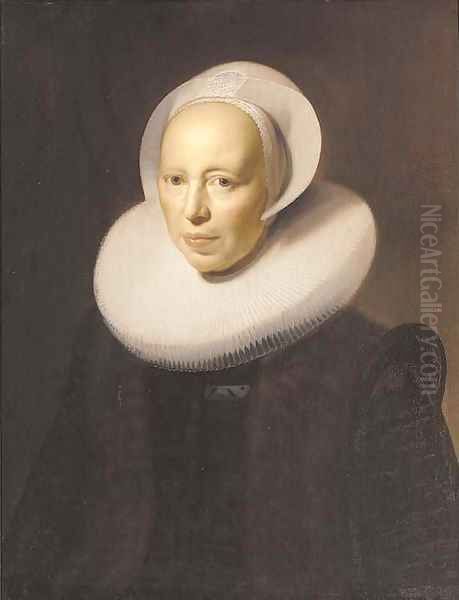
His use of light is generally even and descriptive, illuminating his subjects clearly and highlighting the richness of their clothing and the details of their surroundings. While not employing the dramatic chiaroscuro that would become a signature of his younger contemporary Rembrandt van Rijn, Pickenoy's handling of light and shadow was sophisticated, lending volume and presence to his figures. His compositions, especially in individual portraits, are often elegant and balanced, with sitters typically posed against a neutral background or a subtly indicated interior.
In his group portraits, Pickenoy faced the challenge of arranging multiple figures in a coherent and engaging manner. He often succeeded in creating a sense of individual presence for each member of the group while also conveying their collective identity and purpose. His approach was generally more ordered and less overtly dynamic than that of Frans Hals in Haarlem, but he managed to introduce a degree of interaction and liveliness that moved beyond the more static conventions of earlier group portraiture.
Pickenoy's palette was rich and varied, capable of capturing the somber blacks and whites favored in Calvinist Holland as well as the brighter hues found in sashes, banners, or occasional decorative elements. His brushwork was typically smooth and controlled, contributing to the polished finish of his paintings.
Key Genres and Representative Works
Pickenoy's oeuvre primarily consists of portraits, which can be broadly categorized into individual portraits, group portraits (including civic guard companies and regent groups), and a smaller number of historical or biblical scenes.
Individual Portraits
Pickenoy excelled at individual likenesses, creating numerous portraits of Amsterdam's citizens. A fine example is the Portrait of Johanna Le Maire (circa 1628-1629), now housed in the Rijksmuseum, Amsterdam. This work showcases his skill in rendering the elaborate lace of her ruff and cuffs, the sheen of her dark silk dress, and the delicate modeling of her features. The sitter's dignified pose and direct gaze are typical of his approach.
Another notable work is the Portrait of a Lady (circa 1640-1645), located in the Museo Nacional de Bellas Artes in Buenos Aires, Argentina. This later work demonstrates his sustained ability to capture the sitter's personality and social standing through careful attention to costume and comportment. His male portraits, such as those of merchants or scholars, often include attributes related to their profession, like books, documents, or globes, further contextualizing their identity.
Group Portraits: Civic Guards and Regents
Group portraiture was a particularly Dutch phenomenon, and Pickenoy was a leading practitioner in Amsterdam. He received several prestigious commissions for "schuttersstukken" (civic guard portraits) and "regentenstukken" (regents' portraits). These large-scale works were important public statements, celebrating civic duty, collective identity, and the governance of charitable institutions.
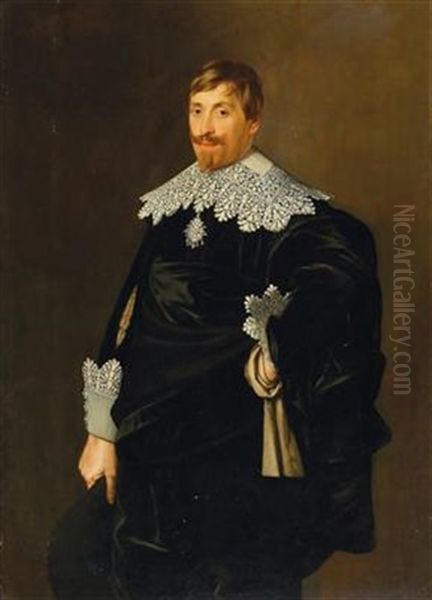
One of his early successes in this genre is the Officers and Other Civic Guards of the XIth District of Amsterdam, under the Command of Captain Jan van Vlooswijck and Lieutenant Pauw (1628). While still adhering to a relatively formal arrangement, Pickenoy manages to individualize the figures and create a sense of camaraderie.
Perhaps his most famous group portrait is The Osteology Lesson of Dr. Sebastiaen Egbertsz. de Vrij (1619, though some sources date it to 1625), located in the Amsterdam Museum. This work predates Rembrandt's more famous Anatomy Lesson of Dr. Nicolaes Tulp (1632) and is a significant example of the "anatomy lesson" subgenre. Pickenoy depicts Dr. de Vrij demonstrating the anatomy of the human skeleton to a group of attentive surgeons. The painting is notable for its clear depiction of the figures, their engaged expressions, and the careful rendering of the anatomical subject. It highlights Pickenoy's ability to handle complex group compositions and to convey a sense of intellectual pursuit.
He also painted The Anatomy Lesson of Dr. Johan Fonteijn (1626). Tragically, this work was severely damaged in a fire at the Surgeons' Guild in 1723, a blaze that also affected Rembrandt's Anatomy Lesson of Dr. Deijman. The surviving fragments, however, still attest to Pickenoy's skill in this specialized form of group portraiture.
Pickenoy also created portraits of the regents and regentesses of various charitable institutions, such as the Regents of the Spinhuis (House of Correction for Women) from 1628, also in the Amsterdam Museum. These paintings typically depict the board members seated around a table, engaged in their administrative duties, emphasizing their probity and civic responsibility. Another example might be related to the St. Catharina Gasthuis (St. Catherine's Hospital), as suggested by the somewhat ambiguous title "St. Catharina Hospital in the Bible" found in some summaries, which likely refers to a group portrait of its governors rather than a direct biblical scene set in the hospital.
A work with attributional complexities is the Company of Captain Matthijs Willemsz. Raephorst and Lieutenant Hendrick Lauwens. While often attributed to Pickenoy and dated around 1630-1645, its definitive authorship and the precise identity of the civic guard company depicted have been subjects of scholarly discussion, highlighting the challenges that can arise in art historical research.
Historical and Biblical Scenes
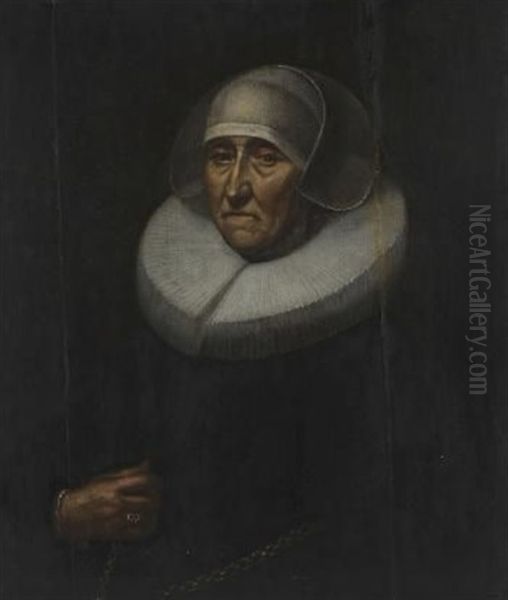
While primarily known as a portraitist, Pickenoy also ventured into historical and biblical subjects, though these form a smaller part of his output. An example is Christ and the Woman Taken in Adultery (circa 1630-1635), housed in the Museum Catharijneconvent in Utrecht. Such works allowed him to explore narrative composition and a wider range of emotional expression than typically found in formal portraiture. These paintings demonstrate his familiarity with broader European artistic traditions, including an awareness of Italianate and Flemish Baroque styles, possibly through prints or the work of other Dutch artists who had traveled, like Pieter Lastman or Jan Tengnagel.
The execution of these historical pieces often shows the same careful attention to detail and rich coloration found in his portraits. They reflect the period's interest in moralizing themes and biblical narratives, which were popular subjects even in the predominantly Protestant Dutch Republic.
Relationships with Contemporaries
Nicolaes Eliasz. Pickenoy operated within a dynamic and competitive art market in Amsterdam, interacting with numerous other painters. His relationship with Rembrandt van Rijn (1606–1669) is particularly noteworthy. For a time, Pickenoy and Rembrandt were neighbors. When Rembrandt moved to a house on the Jodenbreestraat (which later became the Rembrandt House Museum) in 1639, their studios were reportedly connected by a corridor. This proximity would have undoubtedly facilitated artistic exchange, whether through direct conversation, observation of each other's works-in-progress, or shared clientele. Some scholars suggest that Pickenoy's established style may have influenced Rembrandt's early Amsterdam portraits, particularly in their detailed rendering and formal qualities, before Rembrandt developed his more expressive and psychologically penetrating approach.
Thomas de Keyser (c. 1596–1667) was another leading portraitist in Amsterdam and a significant contemporary and competitor of Pickenoy. Both artists catered to a similar clientele and produced works of high quality. De Keyser's portraits are often characterized by a slightly more refined and elegant style, sometimes on a smaller scale, but their careers ran parallel, and they were arguably the two most important portrait painters in the city before the full ascendance of Rembrandt and later, Bartholomeus van der Helst.
Bartholomeus van der Helst (1613–1670) eventually surpassed Pickenoy in popularity, particularly from the 1640s onwards. Van der Helst's portraits were known for their smooth finish, flattering likenesses, and vibrant depiction of textures, appealing greatly to the tastes of Amsterdam's elite. While Pickenoy's influence on Van der Helst is plausible, especially in Van der Helst's early career, the younger artist developed a distinct style that came to define mid-century Amsterdam portraiture.
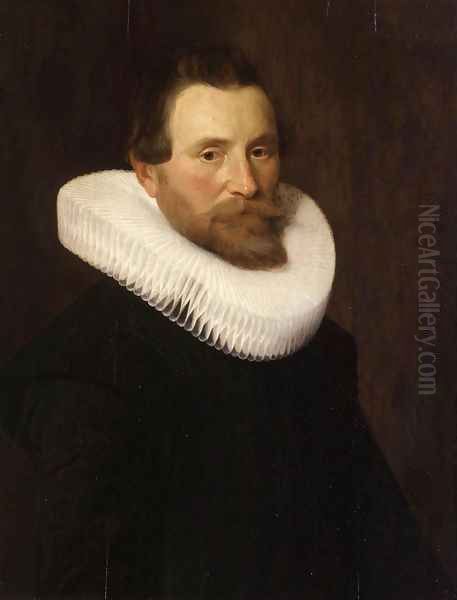
Pickenoy also played a role as a teacher, contributing to the training of the next generation of artists. Pieter Nason (c. 1612–c. 1688/1691) is documented as one of his pupils. Nason later became an independent master in 1639, joining the Guild of Saint Luke, and went on to have a successful career as a portraitist, working in The Hague and for various courts. Another artist sometimes mentioned as a student is Pieter van der Hooghe, though less is known about his career.
Other notable painters active in Amsterdam during Pickenoy's time included Werner van den Valckert (c. 1585–c. 1627), an earlier portraitist, and Jacob Backer (1608–1651), who was known for his portraits and historical paintings and was also influenced by Rembrandt. The broader artistic landscape also included specialists in other genres, such as the landscape painter Jan van Goyen or the still-life master Willem Claesz. Heda, contributing to the rich artistic milieu of the Dutch Golden Age. Figures like Govert Flinck and Ferdinand Bol, both pupils of Rembrandt, would also emerge as significant portraitists, further intensifying the competitive environment. The influence of earlier Amsterdam portraitists like Aert Pietersz. (1550-1612) and Cornelis Ketel (1548-1616) would have formed part of the artistic heritage Pickenoy built upon.
Later Life, Death, and Legacy
Information about Pickenoy's later life is somewhat scarce. His peak period of activity seems to have been in the 1630s. While he continued to paint, the rise of artists like Rembrandt and Van der Helst may have led to a gradual decline in the number of commissions he received, or perhaps he simply chose to work less. The art market was highly competitive, and tastes evolved. Van der Helst, in particular, captured the public's imagination with his polished and elegant style, as seen in his famous Celebration of the Peace of Münster (1648).
There is some uncertainty regarding Pickenoy's exact year of death. Most art historical sources place his death between 1653 and 1656 in Amsterdam. Some records indicate his wife, Levijtje Bouwens, was referred to as a "widow" in documents from 1656, supporting a death date by or within that year. The range 1650-1656 is also sometimes given. This ambiguity is not uncommon for artists of this period where comprehensive biographical records were not always kept or have not survived. His later years seem to have been lived with less public prominence than his peak period.
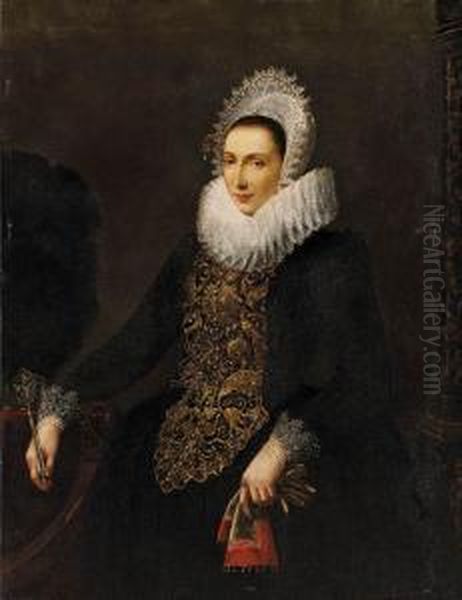
Despite being somewhat eclipsed in fame by Rembrandt and Van der Helst, Nicolaes Eliasz. Pickenoy's contribution to Dutch Golden Age art is undeniable. He was a highly skilled and productive painter who expertly met the demands of Amsterdam's elite for dignified and detailed portraiture. His works provide invaluable visual records of the individuals who shaped one of Europe's most dynamic cities during its cultural zenith.
His group portraits, particularly the anatomy lessons and civic guard pieces, are important documents of social and institutional life in 17th-century Amsterdam. They reflect the civic pride, collective organization, and intellectual pursuits of the era. His individual portraits capture the likenesses of a generation, rendered with a sensitivity to character and a mastery of technique that commands respect.
Pickenoy's style, while perhaps seen as more conservative compared to the innovations of Rembrandt, represents a crucial phase in the development of Dutch portraiture. He refined the traditions he inherited from painters like Cornelis van der Voort and created a body of work that is both historically significant and artistically accomplished. His paintings are held in major museums worldwide, including the Rijksmuseum and Amsterdam Museum in the Netherlands, and collections internationally, ensuring his continued recognition as a key figure in the Dutch Golden Age. His meticulous rendering of costume and his ability to convey the gravitas of his sitters remain his enduring legacy.
Conclusion
Nicolaes Eliasz. Pickenoy was a master of portraiture in a city and an era teeming with artistic talent. For several decades, he was among Amsterdam's leading painters, entrusted with capturing the images of its most prominent citizens and institutions. His dedication to detailed realism, his skillful handling of textures, and his ability to manage complex group compositions solidified his reputation. While the dazzling brilliance of Rembrandt or the fashionable elegance of Van der Helst may have later captured more widespread acclaim, Pickenoy's substantial body of work remains a vital testament to the artistic achievements of the Dutch Golden Age and offers a fascinating window into the society that commissioned and cherished these enduring images. His paintings continue to be studied for their artistic merit, their historical insights, and their representation of a pivotal moment in European culture.